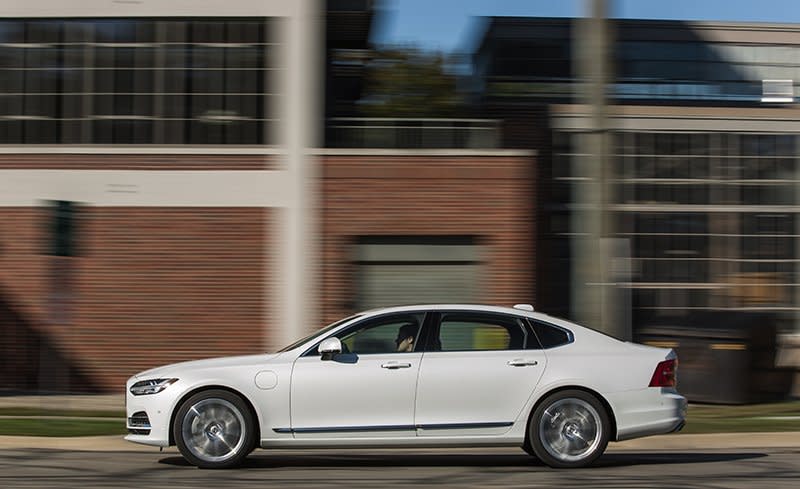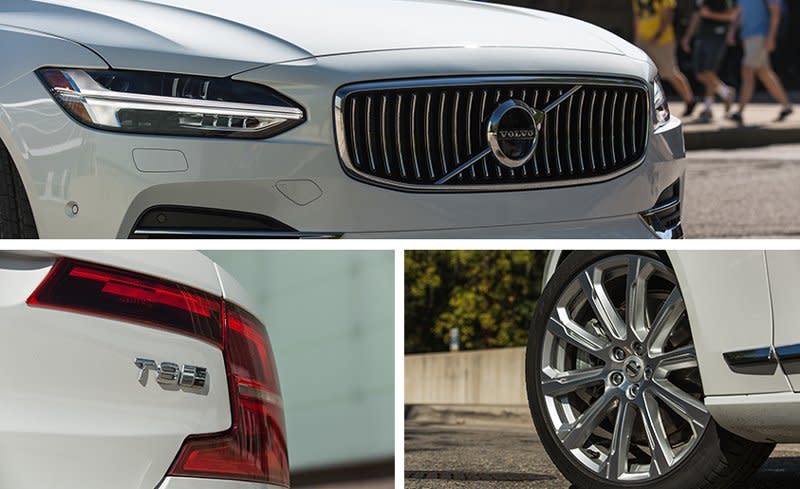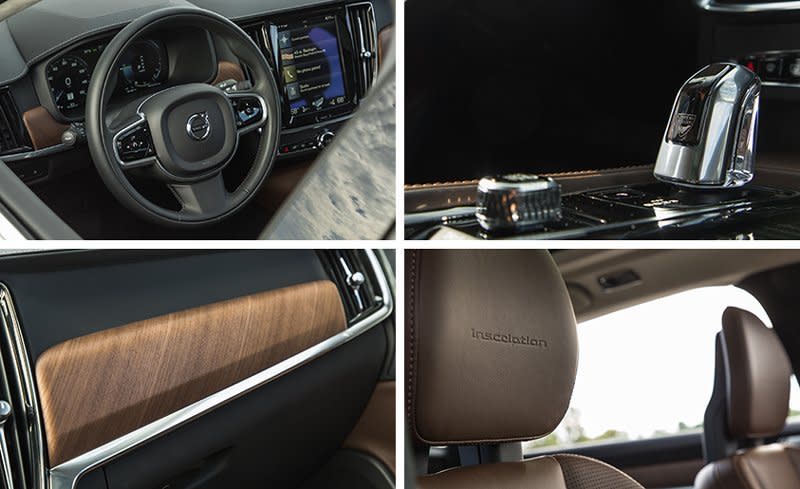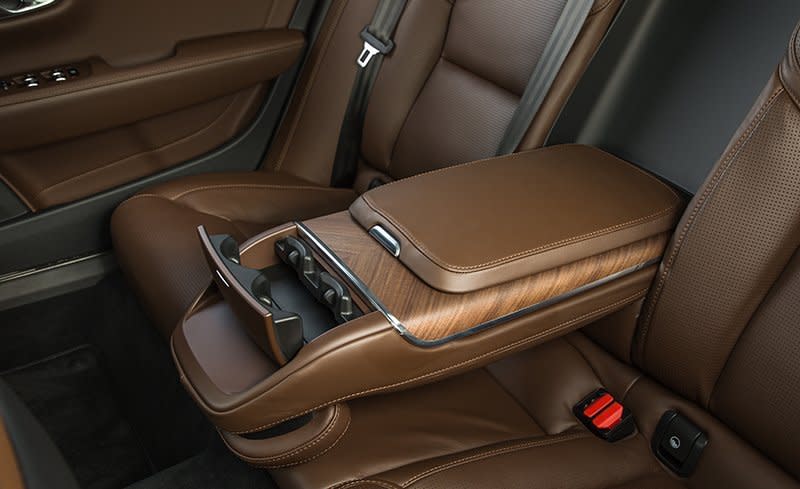2018 Volvo S90 T8 Plug-In Hybrid

Volvo has recently joined the chorus of carmakers proclaiming electrification to be the future. The small Swedish automaker’s assertion is one of the most emphatic, as it promises that every new Volvo model line launched from 2019 onward will incorporate an electric motor in some capacity. And, unlike many of its competitors, Volvo has made considerable progress toward this goal, with several plug-in hybrids already for sale.
The latest electrified Volvo is the S90 sedan, which for 2018 gains a plug-in-hybrid variant called the T8 Twin Engine. It does not, in fact, have two engines, but rather one gasoline four-cylinder engine that’s both supercharged and turbocharged, plus a pair of electric motors. The same setup resides in the T8 versions of the XC60 and XC90 crossovers. An eight-speed automatic gearbox transmits torque from the engine to the front wheels, while a 10.4-kWh lithium-ion battery pack feeds the electric motor positioned at the rear axle; a second motor is integral with the transaxle and also gets engine-starting duties.
Power Play
In terms of acceleration, the S90’s powertrain certainly delivers on its top-of-the-range positioning: The 400-hp hybrid easily outsprinted the lesser T5 and T6 S90s at the test track, putting down a zero-to-60-mph time of 4.5 seconds, 1.1 seconds ahead of the 316-hp S90 T6 and 1.8 ahead of the 250-hp T5. The T8’s time would’ve been good for a second-place finish in that measurement in our latest comparison test of six-cylinder sports sedans, and it wipes the floor with other plug-in luxury sedans, including the BMW 530e (6.1 seconds) and the Cadillac CT6 Plug-In (5.2 seconds).

As with most plug-in hybrids, selecting various driving modes allows you to combine the power sources in different ways. In Pure mode, with the battery fully charged, the Volvo can travel up to 21 miles on electric power alone (according to the EPA) at speeds up to 78 mph, although we struggled to keep the accelerator from dipping too low and thus firing the gas engine even at a moderate pace on 55-mph roads. Hybrid mode lets the car decide how to best utilize the powertrain’s elements, while Power mode puts the maximum amount of grunt to the ground. There are a few other options available in the S90’s tricky-to-master touchscreen, such as a Charge mode that runs the engine in order to recharge the battery pack (it can also be charged by plugging in to an electrical outlet when stopped) and a Hold setting that reserves the battery’s charge in order to save some juice for electric-only driving later on.
The S90 T8 achieved an overall average of 27 MPGe in our hands, a bit lower than the EPA’s 29-mpg combined number for hybrid driving. The S90’s 32-mpg result in our 75-mph highway test also fell slightly short of the EPA’s highway estimate, although it did beat the gas-only S90 T6’s number by 1 mpg. Because Pure mode won’t force the car to stay on a diet of electrons alone, we couldn’t get a reliable electric-only range during our real-world highway test. As always, your mileage may vary wildly depending on how often you plug in your plug-in hybrid.

Changing Gears
Beyond the numbers, the S90’s powertrain works well in the real world, delivering a more seamless driving experience than we remember from our test of the XC90 T8. The handoffs between the electric motor and the gasoline engine are smooth, and the engine is well isolated from the cabin, even if it’s not exactly aurally pleasing. Greater configurability of the regenerative-braking capability would be appreciated—as it is, there’s only one additional setting to increase regeneration, the B position achieved by pulling back the shifter an extra notch.
And about that shifter: While it’s a delicately beautiful piece, made by Swedish crystal company Orrefors, its operation is maddening. A single tap of the gearshift forward or back selects neutral, meaning that two taps forward are required for reverse and two taps backward are needed for drive. It’s even worse if you decide to employ the B position, as shifting from that mode to reverse requires three taps. We never got used to it during our time with the car.
Long and Strong
Electrification isn’t the only change bestowed upon the S90 for 2018, as all versions sold in the United States have a 4.5-inch-longer wheelbase and are imported from China. The S90 now sits at the larger end of the mid-size luxury-sedan class, being about half a foot longer than a BMW 5-series or a Mercedes-Benz E-class. (In China, you can get similarly sized long-wheelbase versions of the Bimmer and the Benz, too.) Luckily, the extra length doesn’t ruin the S90’s fabulous styling; if anything, the long-wheelbase Volvo’s proportions are even more elegant than those of the standard-wheelbase version that is still sold in Europe.

The stretch also improves the S90’s dynamics, most notably its ride quality, which is significantly more settled compared with the choppy body motions we experienced in last year’s shorter model. The Volvo’s overall composure and refinement is now much more befitting of a luxury car, with less flintiness and improved impact isolation over rough roads, although the suspension still gives the impression that it’s always busy. The S90 is not a sports sedan, especially not with the added weight of its extra length and the hybrid powertrain—this T8 is 664 pounds heavier than the short-wheelbase S90 T6 we tested last year. Although grip levels from the 245/40R-20 Pirelli P Zero performance tires are high, at 0.91 g, plenty of body roll accompanies hard cornering in this 4701-pound car. Brake feel is more linear than that of most hybrids with regenerative brakes, if not up to the conventional S90’s standards, and, despite the extra avoirdupois, the S90 T8’s 166-foot stop from 70 mph was only five feet longer than that of its nonhybrid sibling.
Fit for a King
One clear benefit of the added wheelbase is the greatly expanded rear seat, which now offers enough space for passengers to cross their legs. With the addition of the $3450 Luxury package, the rear seat also includes heating and ventilation for the outboard positions and a larger center armrest with more storage.

Gorgeous wood, soft brown leather, and a beautifully sculpted dashboard gave our nearly fully loaded Inscription model an interior ambience that easily lived up to its $82,140 as-tested price. That included extras such as a $900 head-up display, a $3200 Bowers and Wilkins sound system, a $1200 pair of air springs in the rear, and a $2500 Convenience package with a power trunklid, a 360-degree camera system, and park assist. A comparably outfitted S90 Inscription T6 AWD would sticker for roughly $10,000 less.
No matter how it’s equipped, the S90 is an undeniably special piece, with materials and attention to detail that you won’t find in the luxury market short of paying Bentley or Rolls-Royce money. That was true of last year’s short-wheelbase model, and the new stretched S90 is able to provide plush, relaxed dynamics that better match the elegant atmosphere cultivated within. If the strong performance and overall polish of this hybrid powertrain is any indication, then Volvo likely has little to fear from its electrified future.
Specifications >
VEHICLE TYPE: front-engine, all-wheel-drive, 5-passenger, 4-door sedan
PRICE AS TESTED: $82,140 (base price: $64,645)
ENGINE TYPE: turbocharged, supercharged, and intercooled DOHC 16-valve 2.0-liter inline-4, 315 hp, 295 lb-ft; 2 permanent-magnet synchronous AC motors (front: 46 hp, 111 lb-ft; rear: 87 hp, 177 lb-ft); combined output, 400 hp, 472 lb-ft; 10.4-kWh lithium-ion battery pack
TRANSMISSION: 8-speed automatic with manual shifting mode
DIMENSIONS:
Wheelbase: 120.5 in
Length: 200.1 in
Width: 74.6 in Height: 57.1 in
Passenger volume: 102 cu ft
Trunk volume: 14 cu ft
Curb weight: 4701 lb
C/D TEST RESULTS:
Zero to 60 mph: 4.5 sec
Zero to 100 mph: 12.3 sec
Zero to 130 mph: 28.2 sec
Rolling start, 5–60 mph: 5.3 sec
Top gear, 30–50 mph: 2.9 sec
Top gear, 50–70 mph: 3.6 sec
Standing ¼-mile: 13.3 sec @ 103 mph
Top speed (governor limited, C/D est): 140 mph
Braking, 70–0 mph: 166 ft
Roadholding, 300-ft-dia skidpad*: 0.91 g
*stability-control-inhibited
C/D FUEL ECONOMY:
Observed: 27 MPGe
75-mph highway driving, hybrid mode: 32 mpg
Highway range, hybrid mode: 500 mi
EPA FUEL ECONOMY:
Combined/city/highway: 29/26/33 mpg
Combined gasoline+electricity: 71 MPGe
EV range: 21 miles

 Yahoo Autos
Yahoo Autos 